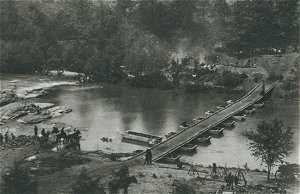
Civil War Pontoon Bridges
by Robert Niepert
Throughout time the common river, whether large or small, has been an obstacle to mankind. Humans and even some animals (primates) and insects (ants) have solved this problem by constructing all types of bridges. A bridge can be as simple as a log across a creek or as incredible as the Pontchartrain Causeway bridge that spans over 23 miles. The common and often unnoticed bridge becomes a prime target or a much sought after asset during a war. Without bridges, supplies and troops cannot move at all or move much slower due to detours around or risky crossings through the river at less than appropriate places. Men at war have had to cross rivers quickly to either gain a tactical advantage or make a hasty retreat. In the absence of existing bridges, the armies in conflict have to rebuild or repair the bridges damaged by war. There is seldom enough time or materials to build permanent bridges so a solution to this problem was needed and the simple pontoon bridge was the answer. These quickly assembled and easily transported bridges are not a concept of modern war.
The First Military Pontoon Bridge
The pontoon bridge has been used extensively throughout
history.
The earliest known use of a pontoon bridge for military gain took place
when the Persian King Xerxes invaded Greece in 480 B.C. Xerxes
planned
his attack for three years and assembled an army numbering over 100,000
men. A military force this large could not be moved by ships and
they would be  discovered
by the enemy if they marched to war across the country. The king
needed a bridge across the strait of Dardenelles (almost a mile wide at
its narrowest point) in Turkey (Hellespont on the Black Sea) to enable
his men to move quickly into battle. King Xerxes came upon the
idea
of building a bridge for his army to cross but how could he build one
that
long? The King ordered his engineers to solve the problem and
they
came up with a new, unique type of bridge. Today we call it a
pontoon
bridge. The engineers decided to use the Kings two largest ships
as anchors at each end of the proposed crossing and move 300 small
ships
into place between them. The two main ships were anchored and the
other small ships moved into place. All the ships were
chained,
bound with hemp and lashed together. Next they started building a
crude roadway across the ships. As the roadway over them was
being
constructed, a fierce storm rolled in and destroyed their yet to be
completed
bridge. At this point, King Xerxes was enraged with the Black Sea
and keeping in the manner of the times he ordered the sea to be beaten
into submission. His "enforcers" gave the waves 300 lashes (one
for
each ship) with their stoutest whips and then the King threw a symbolic
pair of shackles into the water. Next, King Xerxes ordered the
water
branded with hot irons. In his arrogant perception, the hissing
sounds
were the water’s cries of pain. He also blamed the bridges
failure
on his engineers and the King had them beheaded for their
incompetence.
Within hours the weather cleared and newly appointed engineers started
to rebuild the pontoon bridge. The second attempt to build the
bridge
was a success. It took two weeks to build the bridge and an
entire
week to move the men across it. When the King's troops were
assembled
on the other side, they attacked at Thrace. Their invasion was
successful
and they continued pushing forward for a full year until they met with
the combined forces of Greece, the Hellenic League. King Xerxes
had
to quickly withdraw what was left of his men to the point of their
original
crossing. This time there was no bridge and with the Greek army
close
behind, they were forced to disperse and get back to Persia as best as
they could. Soon after his return, King Xerxes was murdered by
his
own palace guards.
discovered
by the enemy if they marched to war across the country. The king
needed a bridge across the strait of Dardenelles (almost a mile wide at
its narrowest point) in Turkey (Hellespont on the Black Sea) to enable
his men to move quickly into battle. King Xerxes came upon the
idea
of building a bridge for his army to cross but how could he build one
that
long? The King ordered his engineers to solve the problem and
they
came up with a new, unique type of bridge. Today we call it a
pontoon
bridge. The engineers decided to use the Kings two largest ships
as anchors at each end of the proposed crossing and move 300 small
ships
into place between them. The two main ships were anchored and the
other small ships moved into place. All the ships were
chained,
bound with hemp and lashed together. Next they started building a
crude roadway across the ships. As the roadway over them was
being
constructed, a fierce storm rolled in and destroyed their yet to be
completed
bridge. At this point, King Xerxes was enraged with the Black Sea
and keeping in the manner of the times he ordered the sea to be beaten
into submission. His "enforcers" gave the waves 300 lashes (one
for
each ship) with their stoutest whips and then the King threw a symbolic
pair of shackles into the water. Next, King Xerxes ordered the
water
branded with hot irons. In his arrogant perception, the hissing
sounds
were the water’s cries of pain. He also blamed the bridges
failure
on his engineers and the King had them beheaded for their
incompetence.
Within hours the weather cleared and newly appointed engineers started
to rebuild the pontoon bridge. The second attempt to build the
bridge
was a success. It took two weeks to build the bridge and an
entire
week to move the men across it. When the King's troops were
assembled
on the other side, they attacked at Thrace. Their invasion was
successful
and they continued pushing forward for a full year until they met with
the combined forces of Greece, the Hellenic League. King Xerxes
had
to quickly withdraw what was left of his men to the point of their
original
crossing. This time there was no bridge and with the Greek army
close
behind, they were forced to disperse and get back to Persia as best as
they could. Soon after his return, King Xerxes was murdered by
his
own palace guards.
Characteristics And Components Of The
Pontoon Bridge
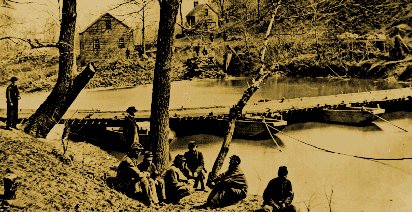
The pontoon bridge is really a very basic, easy to build structure consisting of multiple floating waterborne "pontoons" linked semi-tightly together. The photo above shows the pontoon bridge at Bull Run. This type of bridge floats on the water and has no landborne piers or any other type of permanent under supports. No nails were used in this bridge's construction; everything was lashed together to make the floating bridge flexible, easy to build, dismantle, move and reuse. In one sense, this string of floating components is not really a bridge at all. This "bridge" will get you across the water, but there is often very little space between the pontoons thus making it a floating structure. A pontoon bridge is designed to move (slightly) with the current so it will resist being broken. The entire bridge consists of just a few parts. The most important component of this bridge is, of course, the float or pontoon.
The floating pontoons used in the Civil War era bridges were actually small boats but other ideas were tried. Some early war pontoon bridges were first made using wood frames covered with tin or copper. These were tested and quickly discarded. The first successful type of pontoon experimented with was made of India-rubber. The pontoons were rubber bags shaped like a torpedo. They were inflated and tied together in twos. These pairs of floats were placed and secured side by side across the water and the bridge deck was laid on top of the rubber floats. This type of float was most notably used in the western army by General F. P. Blair's division in the Vicksburg Campaign of 1863.
The wood pontoons used by the Army of the Potomac followed the French style. They were 31 feet long with a flat bottom and squared ends. These floats were very strong and held up well to the rigors of war. The problem with this type of pontoon stemmed from the fact that it was very heavy and hard to transport. In addition, it was hard to repair when damaged. These heavy wood pontoon boat "floats" were used most often in semi-permanent applications or in places where the load to be carried over them and the traffic upon them was heavier than normal. When a long distance was to be crossed such as the Chickahominy, James, Appomattox and the Rappahannock rivers, the wood floats were always used.
In the more common applications, the cumbersome wood pontoon soon gave way to the lighter and easier to work with cotton-canvas float. The cotton-canvas covered pontoons required more maintenance but were light weight and easier to work with and transport. This type of pontoon soon became the standard and replaced the wood type in most applications. The common cotton-canvas float was 26-foot long, 5-foot 6-inch wide, 2-foot 4-inches deep. There was also a smaller 21-foot long size with the same width and depth as the 26-foot type.
 After
unpacking the pontoons from the wagons, the wood frame was set out with
the cotton-canvas material laid out under the frame. The tenons
of
braces and uprights were fitted into mortises, gunwales and endpieces
like
a giant puzzle. The canvas was pulled tight and lashed in the
center
then wrapped around the stern and bow, pulled tightly and lashed down
again.
The entire structure was then soaked in water to make it
watertight.
The drawing here on
After
unpacking the pontoons from the wagons, the wood frame was set out with
the cotton-canvas material laid out under the frame. The tenons
of
braces and uprights were fitted into mortises, gunwales and endpieces
like
a giant puzzle. The canvas was pulled tight and lashed in the
center
then wrapped around the stern and bow, pulled tightly and lashed down
again.
The entire structure was then soaked in water to make it
watertight.
The drawing here on  the
left shows the pontoon after the wood frame has been put together and
before
the cotton-canvas material is tied on. The drawing on the right
shows
the completed pontoon ready to be floated and placed in preparation for
the top deck. The top deck would equally distribute the weight
across
the floats and make the surface or "roadway" of the bridge. It
may
seem at first that these canvas boats would not stand up to much abuse
but in fact they were quite strong when properly rigged and set.
General Sherman used the cotton-canvas type almost exclusively.
When
he left for Savannah, he assigned one pontoon wagon train with nine
hundred
feet of bridge material to each of his four corps.
the
left shows the pontoon after the wood frame has been put together and
before
the cotton-canvas material is tied on. The drawing on the right
shows
the completed pontoon ready to be floated and placed in preparation for
the top deck. The top deck would equally distribute the weight
across
the floats and make the surface or "roadway" of the bridge. It
may
seem at first that these canvas boats would not stand up to much abuse
but in fact they were quite strong when properly rigged and set.
General Sherman used the cotton-canvas type almost exclusively.
When
he left for Savannah, he assigned one pontoon wagon train with nine
hundred
feet of bridge material to each of his four corps.
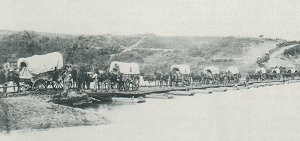
Before going any further with this article, this may be a good place to mention one very unique characteristic of the pontoon bridge. When completed, the bridge due to its construction methods, materials, location and the laws of physics could become unstable and break apart if troops marched across it in step. With the men marching in unison, the walkway would tend to heave up and down. As proven by mathematicians, the reason for this is shown in the equation :
Sigma= 0
In order for the upward buoyancy forces to be exactly equal to
the downward
force of the load, the pontoon has to sink into the water just enough
to
provide the extra flotation force. Consequently as the load
reaches
each floating part of the bridge, that pontoon and each before and
after,
has to sink to gain the necessary buoyancy and recover when the load
has
passed. It 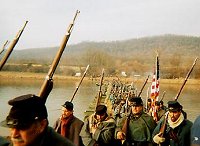 may
seem odd, but the bridges were stressed to their limits by the
infantrymen
while there was little damage caused by the artillery or supply
trains.
To prevent sinking or damaging the bridge, men and animals had to cross
over at a walk. A guard of engineers was posted at each end and
they
barked out the command "Route step!" every so often to remind the
men.
In addition, bridge sentries posted at intervals across the bridge
would
repeat the order and stress caution. If the warnings were heeded,
the bridges were as safe and secure as walking on land. The photo
at left (sent in by Roger Ragland) shows the Union's Irish Brigade
crossing
the Rappahannock in a scene from the movie Gods and Generals.
The pontoon bridge set was built at White Tail, Maryland.
may
seem odd, but the bridges were stressed to their limits by the
infantrymen
while there was little damage caused by the artillery or supply
trains.
To prevent sinking or damaging the bridge, men and animals had to cross
over at a walk. A guard of engineers was posted at each end and
they
barked out the command "Route step!" every so often to remind the
men.
In addition, bridge sentries posted at intervals across the bridge
would
repeat the order and stress caution. If the warnings were heeded,
the bridges were as safe and secure as walking on land. The photo
at left (sent in by Roger Ragland) shows the Union's Irish Brigade
crossing
the Rappahannock in a scene from the movie Gods and Generals.
The pontoon bridge set was built at White Tail, Maryland.
Transporting The Pontoon Bridge
Moving these bridges was not an easy task. A typical bridge train consisted of thirty-four pontoon wagons, twenty-two chess wagons, four tool wagons, and two forge wagons. This train employed a minimum of 368 horses or mules not including the spare animals to take the place of those killed or injured. Enough men were needed to drive the train, build the bridge, maintain the wagons, and take care of the horses. As you can see, the pontoon bridge wagon train is almost an army all by itself. The bridge train and crew would always travel at the end of the army on the move. If the bridge was needed, it was called to the front. When in camp, the pontoon train was located near the headquarters. Below are examples of the two most common wagons.
 The
pontoon wagon.....Shown in this drawing is a wooden pontoon boat of
the French style. A single pontoon was mounted upon a wagon
frame.
The pontoon boat's cable and anchor were placed inside the boat.
The oars, rowlocks, boathooks and ropes were lashed under the rear
axle.
This wagon required that six horses be hitched to it due to its
weight.
In order that the horses not be overtaxed, the boat and its accruements
were all that was allowed to be carried within or upon this wagon.
The
pontoon wagon.....Shown in this drawing is a wooden pontoon boat of
the French style. A single pontoon was mounted upon a wagon
frame.
The pontoon boat's cable and anchor were placed inside the boat.
The oars, rowlocks, boathooks and ropes were lashed under the rear
axle.
This wagon required that six horses be hitched to it due to its
weight.
In order that the horses not be overtaxed, the boat and its accruements
were all that was allowed to be carried within or upon this wagon.
The Chess Wagon......The chess wagon can be loaded one way only. Notice in the drawings below. The chess planks were loaded tightly together vertically with two layers consisting of twenty planks to each layer. Above the first layer, five planks were laid horizontally and another vertical row of twenty planks were laid on top of them. The chess wagon also carried two cables and was drawn by six horses.

Chess Wagon
The Other Wagons......The tool wagons would carry all the other necessary items for the construction of the bridge and the abutments. These wagons carried the entrenching tools, spare cordage, bridge hardware and carpenter's tools. The forge wagons would carry extra iron for the bridge and anchors and would help care for the horses and mules. This entire bridge train would be followed by its own supply train.
Construction Of The Pontoon Bridge
The construction of a pontoon bridge had six specific steps and six distinct crews of specially trained men to execute each of those steps. You may reference the drawing at the bottom of this article to help clarify the steps of construction that follow. Utilizing well trained crews of men, these bridges went together quickly. As an example, the Union army built a 2,200 foot long pontoon bridge across the James River in only five hours utilizing 450 well trained men.
Building The Bridge........The first step in the
bridge's construction
is to determine the best location on the river that is closest to the
point
needing to be crossed. The width of the river and its current
must
be considered first; then secondly, the nature of 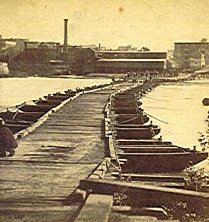 the
river's banks. While all the other crews and wagons were getting
ready, the abutment crew took the first steps to cross the
river.
They quickly began preparing the approaches to the bridge on both
sides.
Sometimes the abutments could be made by just dropping a large timber
at
the edge of the river and leveling dirt to its top.
Unfortunately,
that was not always the case. In order to get a proper approach,
yards and yards of fill dirt may have to be moved in or perhaps a
corduroy
road had to be built through a swampy area or maybe the river's bank
would
have to be cut away. At times, the approaches and abutments were
more trouble to construct than the bridges themselves.
the
river's banks. While all the other crews and wagons were getting
ready, the abutment crew took the first steps to cross the
river.
They quickly began preparing the approaches to the bridge on both
sides.
Sometimes the abutments could be made by just dropping a large timber
at
the edge of the river and leveling dirt to its top.
Unfortunately,
that was not always the case. In order to get a proper approach,
yards and yards of fill dirt may have to be moved in or perhaps a
corduroy
road had to be built through a swampy area or maybe the river's bank
would
have to be cut away. At times, the approaches and abutments were
more trouble to construct than the bridges themselves.
The wagons were pulled up to the river's edge as closely as possible and the boat crew jumped into action. They began to unload the heavy boats or assemble the cotton-canvas ones depending on what type of pontoon was to be used. After at least one, usually two, pontoons had been constructed, and while the abutment crew was still working to finish their job, six men boarded the pontoon boat and rowed out onto the river. The boat crew would row upstream and drop an anchor from their boat. The boat would drift downstream towards the bridge approaches as the men paid out anchor cable. As the bridge was being built and when completed, each pontoon was secured in line by upstream anchors but only every other one was secured with downstream anchors. When the first boat was in its proper place along side the abutment, the men unloaded and got into another boat, made ready for them by other members of the boat crew, to repeat the procedure.
Almost before they could go ashore, the balk crew had
already
started to place the balks from the firm ground of the abutment and
across
the first boat. Balks are 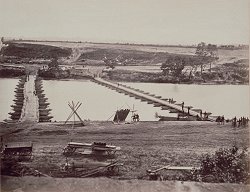 crosstie-like
wood "spacers" that were locked into place on the pontoon's
gunwales.
In addition to acting as spacers, the balks did double duty as the
floor
timbers for the bridge's deck. The bulk crew consisted of ten men
who would carry five planks, two men to each plank. The balks
which
had cleats to hold them in place were set with six inches hanging
beyond
the gunwale on the shore side of the pontoon boat. The next boat
was pushed out by pushing on the ends of the balks. Each "bay" of
balks completely spanned two pontoons. The pontoons were normally
set and held 20 feet apart by the balks; however, the space between the
pontoons could vary depending on the circumstances. When the end
of the balk was reached, they turned the job over to another crew.
crosstie-like
wood "spacers" that were locked into place on the pontoon's
gunwales.
In addition to acting as spacers, the balks did double duty as the
floor
timbers for the bridge's deck. The bulk crew consisted of ten men
who would carry five planks, two men to each plank. The balks
which
had cleats to hold them in place were set with six inches hanging
beyond
the gunwale on the shore side of the pontoon boat. The next boat
was pushed out by pushing on the ends of the balks. Each "bay" of
balks completely spanned two pontoons. The pontoons were normally
set and held 20 feet apart by the balks; however, the space between the
pontoons could vary depending on the circumstances. When the end
of the balk was reached, they turned the job over to another crew.
The lashing crew was waiting with material in hand and started to lash everything together as the balk crew left to retrieve another "bay" of balks from the wagon. The bridge started firming up as the assembly thus far was lashed to the abutment and several pontoons had been spanned.
The chess crew moved up to cover the balks with flooring. The chess planks being 13 feet long were laid at a 90 degree angle to the balks and to within one foot of the pontoon. While all this is going on, the boat crew is still launching and anchoring more pontoons as the abutment/approach crew is finishing up their work. Sometimes the chess crew would lay dirt, hay or brush on the bridge to muffle the noise of the crossing wagons and horses and provide a slight barrier of protection for the chess boards.
Once the chess crew's work had progressed across three pontoons and started the fourth, the side rail crew began placing the rails. The side rails are like curbs and were laid on top of the chesses over the outside balks. The side rails are lashed to the chess planks by passing the lashings through the inside spaces down and under the balks then back up on the outside and fastened in place. These bridges seldom had hand rails but if they were needed they were made from whatever was at hand and put on the bridge by the side rail crew. When the bridge reached the opposite bank and while the final touches were being applied to it, the boat crew was still busy tightening lines, straightening boats and making sure all was well with the pontoons.
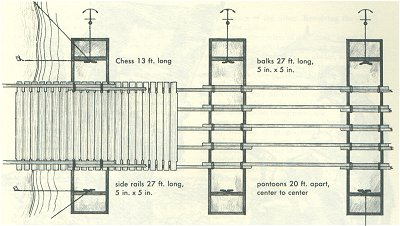
The Rappahannock Bridge
Although pontoon bridges were used extensively in the Civil
War, some
stand out more than others. Perhaps the most famous one was the
bridge
that was built across the Rappahannock River at Fredericksburg.
That
bridge and the battle are depicted in the painting below, "Essayons:
Engineers
at Fredericksburg" by Don Gallon. General Lee was attempting to
hold
ground to delay the Union advance into Richmond. Lee's Army of
Northern
Virginia was spread out along the Rappahannock waiting for
Burnside.
General Barksdale was holding Fredericksburg and trying to slow down
Burnside
long enough to allow Lee the necessary time to regroup. Gen.
Burnside
ordered two pontoon bridges built across the river in order to attack
and
take 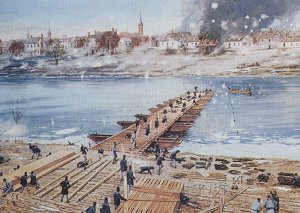 Fredericksburg.
Gen. Barksdale's marksmen sighted in their rifles and sniped at the
working
engineers. The work crews were taking heavy losses and the
bridge's
construction fell way behind. The Union artillery opened fire on
the city with 150 guns but the defending Confederate sharpshooters just
temporarily retreated to the cellars and alleys and suffered few
causalities.
Fredericksburg.
Gen. Barksdale's marksmen sighted in their rifles and sniped at the
working
engineers. The work crews were taking heavy losses and the
bridge's
construction fell way behind. The Union artillery opened fire on
the city with 150 guns but the defending Confederate sharpshooters just
temporarily retreated to the cellars and alleys and suffered few
causalities.
As soon as the engineers went back to work, the Confederate shooters would cut them down again. General Hunt, the Union artillery General, suggested that Gen. Burnside send some of the Federal infantry across the river in the pontoon boats to clear out the enemy sharpshooters. At first his idea was rejected, but soon Burnside saw that there was no other way. The Union men boarded the pontoon boats and set out to establish the first beachhead under fire in American history. The Union was successful in their crossing of the river and landing on the opposite shore but the Confederates of the 8th Florida and the 21st Mississippi refused to give up and fierce building to building combat ensued throughout the afternoon and into the night. Late that night, Barksdale ordered a retreat and his men left Fredericksburg. The Confederates were successful in holding the Union back and the time they allowed Gen. Lee was used wisely when he perfected his defenses.
Above is a painting of the Union General Burnside's pontoon bridge under construction with the Confederate sharpshooters firing away at his bridge crews. This painting shows all the stages of the construction of a pontoon bridge. You can see that the bridge's parts are neatly laid out to the right. The chess boards are stacked just below the cables and anchors and the balks are to the left. The abutment crew has finished their work and is helping lay out the material for the other crews. Notice the boat crew rowing out to set in place another pontoon while the balk crew positions their timbers. Look closely at the end of the bridge and you can see that the chess crew has laid the chess boards to the second from the end pontoon and the side board crew is just behind them. The lashing crew is all along the bridge fastening everything into place.
Pontoon Bridge Maintenance
The pontoon bridge is a high maintenance type of bridge.
It was
necessary to frequently check and clean the area around the 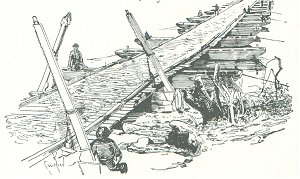 bridge
and the bridge itself. Depending on the length of the bridge and
the size of the river, anywhere from six to twenty men with at least
two
boats were constantly servicing and repairing the bridge 24 hours a
day,
seven days a week. Why is the pontoon bridge such a high
maintenance
bridge? Keep in mind in order to make the bridge, it is necessary
to place the pontoons close together with their anchor lines running up
and down stream and therein lies the problem. Any debris, either
natural or launched by the enemy, floating downstream towards the
bridge's
location would almost certainly become entangled within the anchor
lines
or around the pontoons themselves. This debris had to be removed
immediately or it would pile up around the bridge and the force of the
river's current would cause the eventual destruction of the
structure.
Even if the river was relatively free from floating debris, the anchor
and guide lines still needed to be constantly checked and repeatedly
tightened.
Men walked the length of the bridge constantly checking the
floats.
Both the cotton-canvas and wood pontoon floats leaked and had to be
bailed
out often.
bridge
and the bridge itself. Depending on the length of the bridge and
the size of the river, anywhere from six to twenty men with at least
two
boats were constantly servicing and repairing the bridge 24 hours a
day,
seven days a week. Why is the pontoon bridge such a high
maintenance
bridge? Keep in mind in order to make the bridge, it is necessary
to place the pontoons close together with their anchor lines running up
and down stream and therein lies the problem. Any debris, either
natural or launched by the enemy, floating downstream towards the
bridge's
location would almost certainly become entangled within the anchor
lines
or around the pontoons themselves. This debris had to be removed
immediately or it would pile up around the bridge and the force of the
river's current would cause the eventual destruction of the
structure.
Even if the river was relatively free from floating debris, the anchor
and guide lines still needed to be constantly checked and repeatedly
tightened.
Men walked the length of the bridge constantly checking the
floats.
Both the cotton-canvas and wood pontoon floats leaked and had to be
bailed
out often.
Removal Of The Pontoon Bridge
The removal of the pontoon bridge depended entirely on one relevant fact: if the owners of the bridge were the winners or losers of the battle. If the bridge's builders had won the battle and were in no hurry, the bridge was disassembled in the exact reverse of its assembly and loaded neatly on the wagons. If a fast retreat was called for and the enemy was close behind, the disassembly took on another aspect. The quickest way to remove the bridge was for the boat crew to row out and just cut the anchor lines starting on the far shore side and working toward the near side. The bridge would then slowly drift to the desired side of the river where a hasty disassembly could be done.
References:
Time Life Books
American Civil War
Hard Tack and Coffee
Time Tables of History
More Civil War Curiosities
History of Greece (third edition)
Portland State University Library
Bridge Watching by Edmund Jupp
Dictionary of Phrase and Fable. 1898
Arms and Equipment of the Civil War
Athens and the Persian Wars Lecture 11
Engineers at Fredericksburg by Dale Gallon
National Archives American Civil War Images
Gardner's Photographic Sketchbook of the War. (Vol. I)